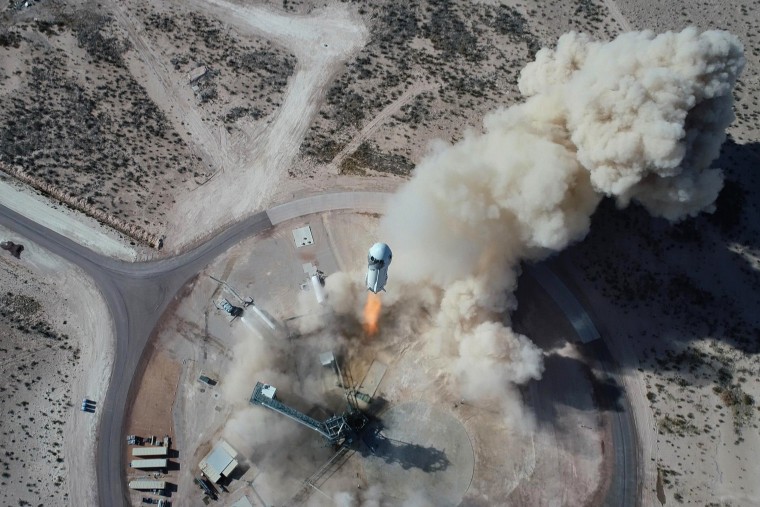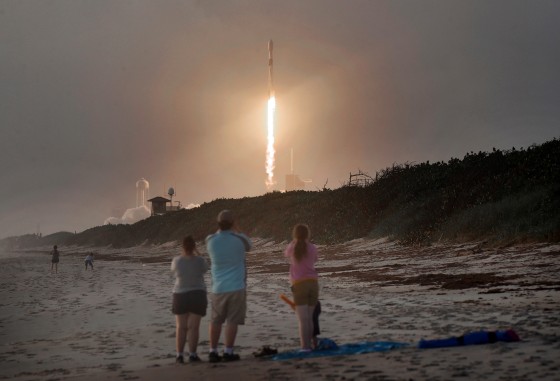In space, business is booming.
From joyrides for space tourists to science experiments in microgravity to giant “megaconstellations” of satellites that beam high-speed internet to the ground, a thriving ecosystem of goods and services has emerged in orbit around Earth and beyond.
The flurry of activity has been driven in recent decades by significantly lower costs to launch into space, the availability of smaller, cheaper components to build satellites and other spacecraft, and the growth of private space companies. It has revamped the orbital landscape, dramatically expanding access to the cosmos and fueling what is projected to grow into a trillion-dollar commercial space industry.
Companies that once had to pay hundreds of thousands of dollars to put a satellite into orbit can now do the same for a fraction of that price. Smaller satellites and lower launch costs mean startups and students can sometimes launch projects for just a few thousand dollars.
“It’s a huge sea change from the former paradigm,” said Ariel Ekblaw, founder and director of the MIT Space Exploration Initiative.
Once a realm dominated by just a few spacefaring nations, the cosmos is opening up to nascent space programs around the world, to entrepreneurs and innovators, to commercial companies and even to students. Yet alongside the numerous benefits to society, increasing access to space and supporting an economy in orbit comes with its share of challenges, including how to balance a growing industry with the safe and sustainable use of outer space.
“How can we make sure that we are taking advantage of the opportunities but also be well aware of the responsibility that comes with that?” Ekblaw said.
Falling costs, rising interest
In recent years, as it became more affordable to send satellites and other objects into orbit, access to the cosmos was democratized, said Josef Koller, a systems director for the Center for Space Policy and Strategy at The Aerospace Corp.
“Twenty years ago, space launches were a very government-dominated capability,” Koller said. “Now, there’s much more room to innovate.”
The emergence of new commercial launch providers, such as SpaceX and Rocket Lab, created a competitive market that drove down the price of rides to space.
Rocket Lab, an aerospace company founded in New Zealand and headquartered in Long Beach, California, debuted its Electron rocket in 2018. The company provides launches to Earth orbit for small satellites, which range from CubeSats roughly the size of a loaf of bread to minifridge-sized spacecraft that weigh less than 1,100 pounds. Rocket Lab charges around $5 million per flight, a cost that works out to roughly $10,000 per pound of payload.
SpaceX offers even more competitive pricing for rides aboard its medium-lift Falcon 9 rocket. The company typically charges around $62 million per launch, or around $1,200 per pound of payload to reach low-Earth orbit. Last month, however, SpaceX announced that it will raise the price of its products and services due to inflation, with a Falcon 9 launch now costing $67 million, a roughly 8 percent increase.
Still, the price represents a steep decline compared to more traditional options. NASA’s space shuttles, which were retired in 2011, cost an average of $1.6 billion per flight, or nearly $30,000 per pound of payload (in 2021 dollars) to reach low-Earth orbit, according to an analysis by the Center for Strategic and International Studies. Russia’s workhorse Soyuz rockets, on the other hand, can cost anywhere from $53 million to $225 million per launch, working out to more than $8,000 per pound of payload to reach Earth orbit.

More rockets, smaller satellites
The competitive launch market has been a boon for companies such as Planet, which maintains a fleet of more than 200 small, remote-sensing satellites that capture constant round-the-clock views of Earth. The ability to pay for rides on rockets specifically designed to carry CubeSats and other small payloads, in particular, introduced new ways for Planet and other space startups to reach orbit.
“When we were starting the company about 10 years ago, it was hard to even get some of the launch providers to pay attention to us, because small sats were still viewed as kind of an academic hobby,” said Mike Safyan, Planet’s vice president of launch.
Safyan said Planet was able to build up its “flock” of satellites as more affordable rockets came to the fore, which eventually generated a cycle of supply and demand.
“It’s a taboo word in the launch world, but we’re now seeing just an explosion of options,” he said. “It’s from both traditional players that normally ignored small satellites but are now offering services and resources and then also new players that have come up in the past five to seven years to specifically address these booming markets.”
The miniaturization of microprocessors and other components for building satellites also helped early private space companies get off the ground, said Charity Weeden, vice president of global space policy and government relations at Astroscale U.S., a private company that specializes in satellite servicing and orbital debris removal.
But perhaps the biggest game-changer was that companies and research institutions now had the ability to choose how and when they could launch to space. Rather than being limited to rides on government-operated rockets, commercial launch providers offered a buffet of options instead. Customers could select among different sizes of rockets to suit their needs, consider the location of the spaceports and even decide which method of delivering their payloads into orbit might work best — whether on a traditional rocket launched vertically or from a modified aircraft or balloon.
“Before, it was like waiting for a seat on the bus, where you have to go to a specific bus stop and maybe you’ll get a seat or maybe not, and then you’re dropped off in a general area but not your specific destination,” Weeden said. “When it comes to these new launch providers, it’s the difference between a bus and an Uber. Now you can say: ‘I want to be picked up at this time, and here’s where I want to go.’”
That freedom to choose “revolutionized” academic research, Ekblaw said. Instead of having to wait and apply for grants through NASA, for example, students could exert more control over their experiments.
“If you were a Ph.D. student in the prior domain, it could have taken years and you may never have had a chance to actually deploy your research on the International Space Station,” she said. “But now, within four to six years, we might do three or four missions to the International Space Station within that time.”

Overcrowding in low-Earth orbit
One consequence of opening up access to space, however, is increased congestion. Low-Earth orbit, the prime real estate surrounding the planet that is still relatively close to the surface, is already becoming a crowded place.
Speckled among the operational satellites in low-Earth orbit are thousands of tons of space debris, ranging from tiny flecks of paint to spent rocket parts to huge defunct spacecraft that have languished in orbital graveyards for decades. Adding more satellites to the mix not only increases the chances of a catastrophic on-orbit collision, but also pushes humanity closer to a perilous tipping point, beyond which certain parts of low-Earth orbit may become too cluttered and risky to operate in safely.
“We’re really on borrowed time before we have another big collision,” Weeden said. “There are thousands of close calls every day in orbit.”
In 2021, there were 1,702 new satellites launched into Earth orbit, bringing the total number of satellites operating in that part of space to 4,852, according to the Union of Concerned Scientists. That figure is nearly double the number of satellites that were operating around Earth in 2018, merely three years before.
Much of the recent overcrowding in orbit is exacerbated by companies such as SpaceX and OneWeb that are assembling huge megaconstellations consisting of tens of thousands of internet satellites around Earth. Amazon similarly announced plans this week to launch thousands of communication satellites into low-Earth orbit to provide high-speed internet around the world.
But placing all the blame on these megaconstellations is oversimplifying the problem, said Darren McKnight, a senior technical fellow at LeoLabs, a California-based aerospace company that operates networks of ground-based radars and tracking systems to monitor objects in low-Earth orbit and map their movements.
For one, operational satellites make up only a small fraction of the total number of objects in low-Earth orbit that pose collision risks, he said. And unlike defunct spacecraft that have languished in orbit for decades, most newer satellites can be maneuvered out of harm’s way, if necessary.
It has also become standard practice for satellite operators to have an end-of-life plan to cut down on the accumulation of space junk. These strategies include purposefully commanding a spacecraft to “deorbit,” or burn up harmlessly in Earth’s atmosphere, or strand it in a higher, “graveyard” orbit away from the most congested sections around the planet.
Still, the risks are serious. And the amount of debris in space is expected to grow as launches continue. McKnight said “bad neighborhoods” have already emerged — areas in low-Earth orbit where big clouds of debris pose very real threats.
“There are certain places in Earth orbit where we are destined to have a major event within the next five to 10 years,” he said. “We’re looking at a 10 to 15 percent probability of a collision, which sounds unlikely, but by leaving these objects in orbit since the mid-’80s, we’re rolling the dice a lot.”
These risks were amplified by a series of recent anti-satellite missile tests — one conducted by China in 2007, one by India in 2019 and one carried out by Russia last year — and a separate accidental collision between two satellites in 2009. Each event is estimated to have produced thousands of pieces of debris larger than the size of a golf ball, and even smaller, harder-to-track objects, according to the Secure World Foundation, a nongovernmental organization that focuses on space policy.
LeoLabs is just one of a slew of commercial companies trying to boost situational awareness in space and help preserve low-Earth orbit. In addition to LeoLabs’ exhaustive mapping and tracking, companies such as Astroscale are working on ways to extend the lives of satellites in space and developing technologies to actively remove objects from orbit.
Part of the problem is that while launches are subject to domestic regulations in individual countries, there is no international body to oversee what happens in orbit. Policies have yet to catch up with the industry’s growth, and it’s unclear if any binding global agreements can be achieved anytime soon.
“It’s like we’re building the plane as we’re flying it,” Koller, of The Aerospace Corp., said.
Yet, with society’s reliance on satellite systems for everything from telecommunications to security and defense, the stakes for maintaining sustainability in space are high, said Weeden, who also serves as chair of the Commercial Space Transportation Advisory Committee, part of the Federal Aviation Administration.
“All of us around the world are users of space, whether or not our country has satellites in orbit,” she said. “Our daily lives are dependent on space, so I feel passionately that this is a galvanizing item for humanity.”

